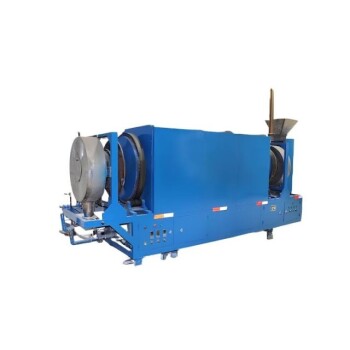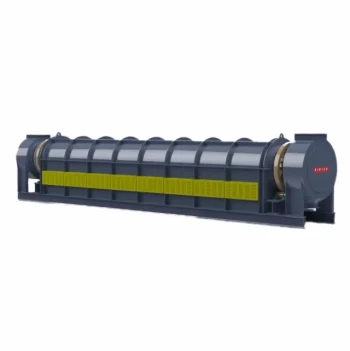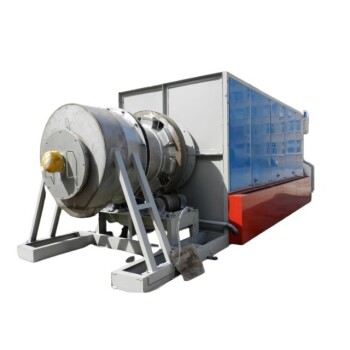At its core, a rotary kiln is designed to process flowing solid materials that require continuous, high-temperature thermal treatment. While it is famous for producing commodities like cement and lime, its capabilities extend to a wide range of powders, granules, and even slurries that become solid upon drying. The selection of a raw material depends less on its chemical composition and more on its physical behavior at high temperatures.
A rotary kiln is not limited to a specific list of materials. Instead, it is a specialized tool for any particulate or granular solid that can flow and tumble, enabling uniform heating, drying, calcination, or chemical reaction in a continuous process.
How a Rotary Kiln's Design Dictates Material Choice
The function of a rotary kiln is directly tied to its unique mechanical design. This design inherently favors certain types of raw materials while excluding others.
The Principle of Continuous Flow
A rotary kiln is a long, rotating cylinder mounted at a slight angle (1% to 4% inclination). This combination of rotation and slope forces the material to move continuously from the higher feed end to the lower discharge end.
This mechanism is why the ideal raw materials are powders, granulates, and particulates. These materials flow predictably through the kiln, ensuring consistent processing time.
The Importance of Thermal Uniformity
As the kiln rotates, the material bed is constantly tumbling. This action, known as cascading, exposes all surfaces of the particles to the hot gases and the heated refractory lining.
This tumbling ensures exceptionally uniform heat transfer, which is critical for processes like calcination (decomposing a material with heat) or sintering. Most kilns use a counter-current heat flow, where the burner is at the discharge end, maximizing thermal efficiency.
Diverse Material Forms and Compositions
Given these principles, rotary kilns process an extensive variety of materials that can be broadly categorized.
- Minerals and Ores: This is the most common application. Examples include limestone and clay for cement, gypsum for refractories, and fine iron ore that is agglomerated into iron ore pellets.
- Engineered Powders: The kiln is used to create or modify advanced materials. This includes producing titanium dioxide (a white pigment), alumina, and metakaolin from their respective precursors.
- Specialty and Chemical Materials: With precise control, kilns process materials like catalysts, ceramic powders, carbon-based materials, and various metal oxides, sulfides, and nitrides.
The Role of Controlled Atmospheres
Modern kilns can be sealed to control the internal atmosphere. By replacing air with an inert gas like argon, unwanted chemical reactions such as oxidation or nitriding can be prevented.
This capability makes the rotary kiln suitable for processing sensitive raw materials like pure metal powders or other reactive compounds.
Understanding the Trade-offs and Limitations
While versatile, the rotary kiln is not a universal solution. Its design creates specific limitations that must be understood.
The "Stickiness" Problem
The single greatest constraint is material behavior at high temperatures. Materials that become sticky, soft, or semi-molten are not suitable for rotary kilns.
Sticky materials will clump together instead of tumbling freely. Worse, they will adhere to the hot refractory wall, disrupting material flow, causing massive buildups, and ultimately forcing a shutdown.
Unsuitability for Static or Liquid Processing
By design, a rotary kiln cannot process large, single objects that cannot tumble. It is fundamentally a machine for moving bulk solids.
While it can handle slurries or suspensions, this only works because the liquid evaporates in the initial drying zone, leaving behind a solid that can then flow and tumble through the rest of the kiln.
Mechanical Wear and Tear
The continuous rotation and high temperatures place significant stress on the kiln's components. The refractory lining that protects the steel shell eventually erodes and must be replaced.
Furthermore, the drive systems, support wheels, and seals are all moving parts that require regular maintenance, unlike a simpler static furnace.
Making the Right Choice for Your Goal
The decision to use a rotary kiln depends entirely on your raw material's properties and your desired outcome.
- If your primary focus is large-scale mineral calcination: The rotary kiln is the industry standard for efficiently and uniformly processing huge volumes of materials like limestone to produce cement and lime.
- If your primary focus is ore agglomeration: The kiln's tumbling action is perfect for forming and heat-hardening fine ore dust into durable pellets, as seen in iron production.
- If your primary focus is advanced material synthesis: The kiln offers precise thermal control and atmospheric management for producing high-value powders like catalysts, pigments, or specialized ceramics.
Ultimately, the rotary kiln is the definitive workhorse for any process requiring the continuous and uniform thermal treatment of flowing solids.
Summary Table:
| Material Category | Examples | Key Process |
|---|---|---|
| Minerals & Ores | Limestone, Clay, Gypsum, Iron Ore | Calcination, Agglomeration |
| Engineered Powders | Titanium Dioxide, Alumina, Metakaolin | Synthesis, Calcination |
| Specialty & Chemical Materials | Catalysts, Ceramic Powders, Metal Oxides | Controlled Atmosphere Processing |
| Material Form | Powders, Granulates, Particulates, Slurries | Drying, Uniform Heating |
Optimize Your Thermal Processing with KINTEK Solutions
Leveraging exceptional R&D and in-house manufacturing, KINTEK provides diverse laboratories and industrial facilities with advanced high-temperature furnace solutions. Whether your goal is large-scale mineral calcination, ore agglomeration, or advanced material synthesis, our rotary kilns are engineered for continuous, uniform thermal treatment of flowing solids.
Our product line, including Rotary Furnaces, is complemented by our strong deep customization capability to precisely meet your unique material and process requirements, ensuring efficient and reliable operation without the issues of material stickiness or non-uniform heating.
Ready to enhance your production process? Contact our experts today to discuss how a KINTEK rotary kiln can be tailored for your specific raw materials and operational goals.
Visual Guide

Related Products
- Electric Rotary Kiln Continuous Working Small Rotary Furnace Kiln for Pyrolysis Plant Heating
- Electric Rotary Kiln Pyrolysis Furnace Plant Machine Small Rotary Kiln Calciner
- Split Multi Heating Zone Rotary Tube Furnace Rotating Tube Furnace
- Electric Rotary Kiln Small Rotary Furnace Biomass Pyrolysis Plant Rotating Furnace
- Electric Rotary Kiln Small Rotary Furnace for Activated Carbon Regeneration
People Also Ask
- How is bed depth controlled in a rotary kiln and why is it important? Optimize Heat Transfer and Efficiency
- What is the basic working principle of a rotary kiln? Master Industrial Thermal Processing Efficiency
- What are some drying applications of electromagnetic rotary kilns? Discover Efficient, Precise Drying Solutions
- What is an electric heating rotary kiln and what industries use it? Discover Precision Heating for High-Purity Materials
- What advantages do electrically heated rotary kilns offer in temperature control? Achieve Precision and Uniformity for Superior Results



















